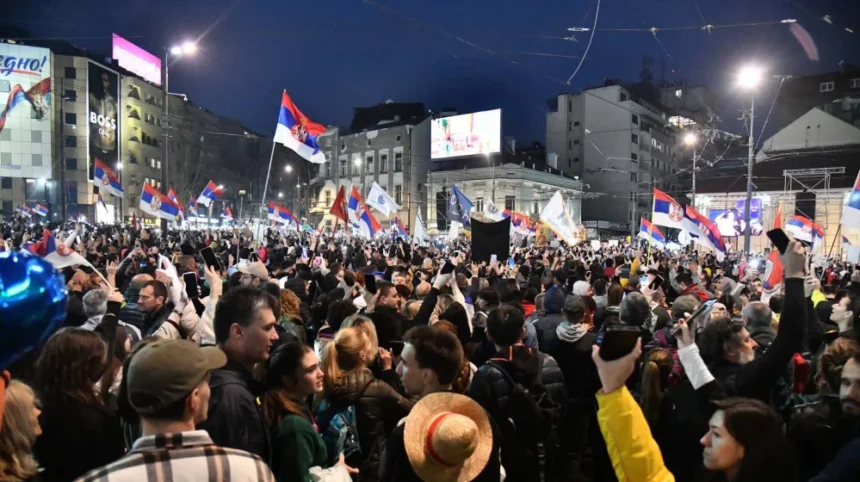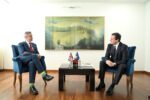As the Saturday 9 PM deadline approaches—the ultimatum given by students to the authorities to call elections—no one in Belgrade knows exactly what will unfold. Expectations are varied, while President Aleksandar Vučić attempts to dismiss the protests as a failed endeavor.
By Saturday evening, around 6 PM, as crowds are expected to fill Slavija Square, the heat will be more bearable than in previous days, with forecasts of 29 degrees Celsius, possibly cloudy, and no rain. This colossal roundabout, though not traditionally a protest site in Serbia, has gained significance during the student uprising. If the crowd is large enough, it provides impressive drone shots, with thousands of mobile phone lights illuminating Belgrade after dark.
Vidovdan, a mythical day in Serbian history, might gain another large gathering, reigniting huge expectations among opposition-minded citizens. These expectations were fueled by students in blockades, who, in an open letter to the Assembly, issued an ultimatum: call elections and remove the “students who want to learn” tent camp in the city center. Otherwise, they warned of “civil disobedience.”
What exactly will happen at 9 PM on Saturday, given that the authorities are unlikely to meet the ultimatum? For now, no one knows.
Numbers (Don’t) Matter
Students are, as usual, keeping their cards close, while pro-regime media claim to have “uncovered the plan,” alleging intentions to block major arteries like Autokomanda and Branko’s Bridge, the Vinča landfill, and engage in “violence” and “expulsion” of foreign investors.
Philosopher Vladimir Milutinović, who plans to attend the protest, expects nothing of the sort. No drama, no day of reckoning. “I only expect to show that the student-citizen movement is growing,” he tells DW. This doesn’t necessarily mean more people than at the March 15 gathering, which, according to the Public Assemblies Archive, drew around 325,000. Repeating such numbers in late June, when many are on vacation, is likely unrealistic.
“But the number of people should show that we are all on the same political positions as we were in March,” Milutinović continues. “So, on Vidovdan, one should feel how the wind of change raised by Serbian students is already blowing through all open windows. That the political weather is clearing up, and that it is clearly visible who is who and where.”
The “Grinding” Phase
Since the mid-March protests, trenches have been dug, but there has been no significant movement on the front lines. Students have distilled all their previous demands into one: snap elections.
Serbian President Aleksandar Vučić refuses to consider it. He insists elections will only be held in December 2026, once everything is prepared for Expo, the government’s pet project, which, with various associated infrastructure projects, is estimated to cost around 18 billion euros.
Vučić also stated on Thursday that the Vidovdan protest “will amount to nothing,” no matter how many people come or how angry they are. “They don’t understand that there are people who live and fight for Serbia, people you cannot scare, nor blackmail, people who fear nothing and no one,” Vučić boasted on Instagram.
Although the front line is established, various developments are occurring: blockades persist, but more and more faculties are attempting to circumvent them with online classes. Ahead of the protest, arrests continue of individuals allegedly planning “bloodshed.” Firings are happening in media and schools.
After the strong surge of protests after the fall of a canopy in Novi Sad and the deaths of sixteen people, when authorities seemed at a loss, it is now a phase of “mrcvarenja” (grinding). This is the view of political scientist Duško Radosavljević, who adds that this “grinding” aligns with the character of the head of state.
“For reasons known only to him, which we believe are deeply corrupt, he does not want, cannot, and will not step down, although he knows that the predominant parts of society are against him and the regime, not wanting him to continue ruining the state and citizens. In the situation of a groggy boxer, he punches left and right, missing under the visible effect of fear,” Radosavljević told the Belgrade magazine “Vreme.”
If the authorities are “groggy,” Radosavljević says, a knockout from students and citizens, or “another fatal mistake by the regime that would mark its end,” is still awaited.
Who Has More Time?
However, impatience is also part of the ritual of all protest movements in Serbia, including this one, which is the longest-lasting. Many were disappointed after March 15 when everyone simply dispersed. There was talk of “wasted energy” and a “missed opportunity.” This puts pressure on students to organize a different, perhaps more radical, protest this time, hoping that citizens will follow.
Analysts critical of the regime believe that only significant street pressure can force Vučić into snap elections, which he previously resorted to often and willingly. Because, they say, the popularity of the Serbian Progressive Party (SNS) has dramatically declined.
For instance, Nova Srpska Politička Misao (NSPM) reported that today, SNS would have 33.5 percent of the votes, while a united opposition and student list would have 43.6 percent—with the caveat that SNS exists, while the “united list” is still uncertain.
Đorđe Vukadinović, editor of NSPM, is not surprised by such a balance of power, but he is surprised that it has persisted since March. “Because there has been material fatigue on the protest side, but the situation remains the same. This means that a clear majority of citizens are against Vučić,” Vukadinović told N1 television.
For Vladimir Milutinović, this precisely means there should be no impatience. “If the student movement grows, it will start to control the situation, and their opponents will only be able to watch their support dwindle every day, so let them call elections whenever they want,” he adds for DW.
During this waiting period, other issues will need to be resolved, such as how to finish the academic year and start a new one. There is disunity on this within the universities themselves, but that is probably a question for after the protest.
Fear of Violence
All these desires, intentions, plans, and illusions will converge in the center of Belgrade on Vidovdan and no one can predict the outcome.
The fear of violence is not unfounded—the authorities were accused that at the last major protest, they attacked demonstrators in Ulica kralja Milana with a sonic weapon, which led to a stampede, injuries, and psychological distress.
This time, Vučić (speaking in the first-person plural) announces that the police will be ready to intervene against “nasilnika” (thugs) who “wish evil to their country, state, and people.”
“If we have to, of course, we will intervene, but I hope they won’t force us to,” he said, repeating accusations that the other side consists of violent individuals.
Yet, the students in blockade are, even while issuing their ultimatum, repeatedly stated that they oppose all violence and have never been violent.
Perhaps Vučić’s words are part of a tried-and-true tactic—to scare people, so some do not even come to the protest.
If the protest does indeed extend into blockades, meteorologists predict an acceptable 30 degrees Celsius and sunny weather for Sunday. The coming week, however, promises to be scorching.







